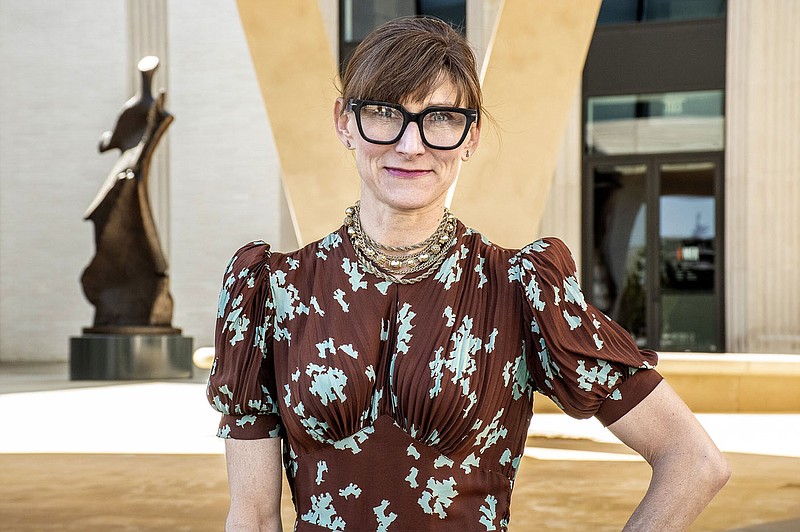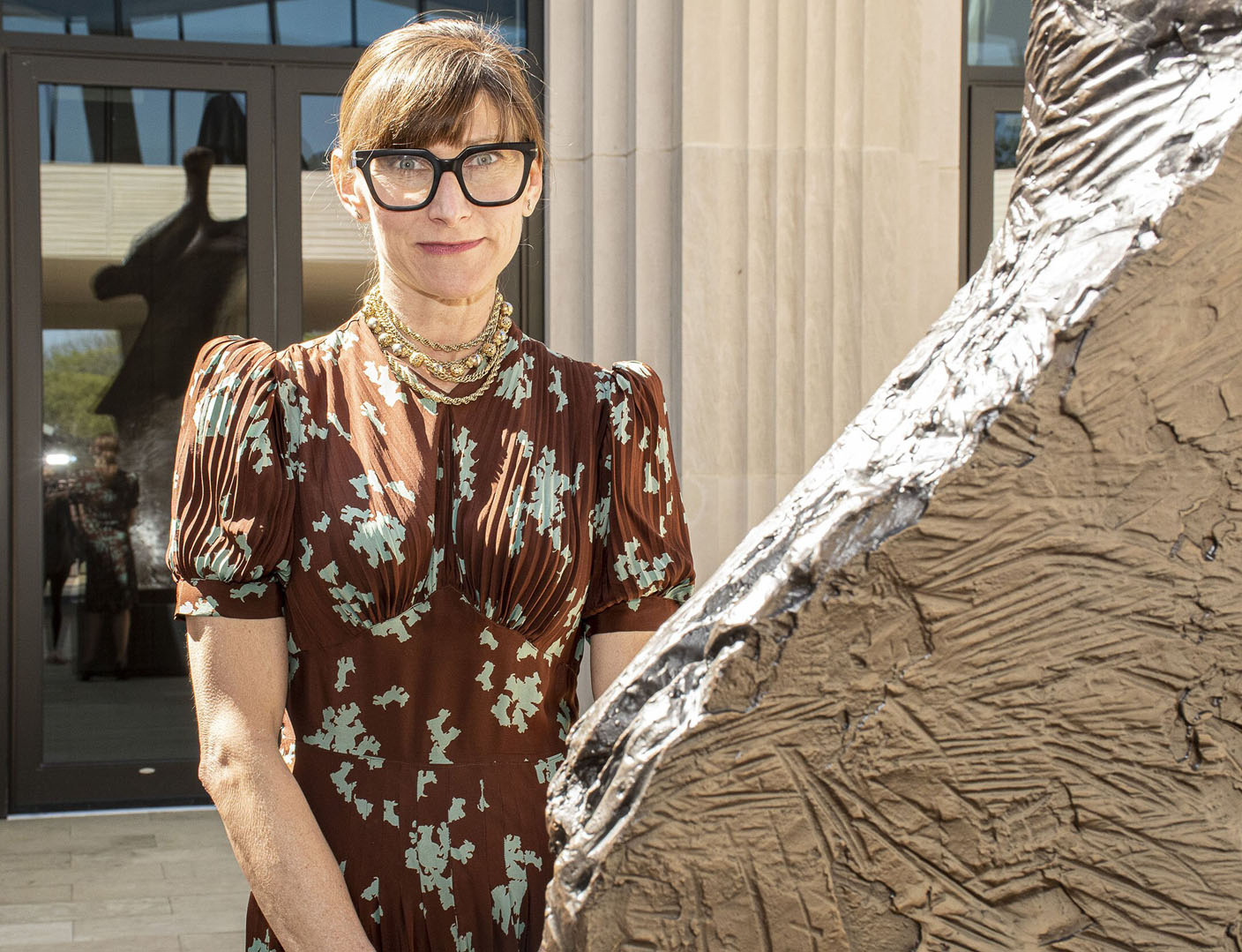Central Arkansas art lovers have been counting down the days to Saturday -- the day the curtain came up on the Arkansas Museum of Fine Arts -- as if it was a second Christmas.
Cultural events in Arkansas don't get much splashier than the grand reopening of Little Rock's former Arkansas Arts Center. The longtime museum arts complex, situated in MacArthur Park, was shuttered in July 2019 to undergo a major renovation -- coming at the hands of internationally recognized architect Jeanne Gang -- and a name change to Arkansas Museum of Fine Arts. The changes come after a capital campaign that raised more than $150 million.
The museum is not a cosmetic touch-up of the old Arts Center. The new space features a spiffy 133,000-square-feet housing The Windgate Art School, Harriet and Warren Stephens Galleries, a performing arts theater, a restaurant and more. Eleven acres of landscaping in MacArthur Park by award-winning landscape architect Kate Orff of SCAPE Landscape Architecture add to the excitement of the unveiling.
It's safe to say very few will have a greater anticipation of what artistic delights the Arkansas Museum of Fine Arts will hold than Catherine Walworth -- even as she helped select a significant portion of what visitors will see when the museum's doors open. Walworth came on board the museum as the Jackye and Curtis Finch Jr. Curator of Drawings in 2022.
"The collection at [the Arkansas Museum of Fine Arts] is phenomenal," Walworth, 49, says. "It's a pleasure to have options to work with."
"[Walworth has] a pretty important role," says Arkansas Museum of Fine Arts Executive Director Victoria Ramirez. "It's a role that represents the entire institution by selection, by what we put on display. That says to the community who we are. It's one of those roles that contributes to the museum legacy. This is about today and the future."
By any measure, Walworth's credentials would earn the attention of any museum across the country. She has served as a curator for the McNay Art Museum in San Antonio, the Cleveland Museum of Art, Pittsburgh's Carnegie Museum of Art and the Columbia Museum of Art. She has a Ph.D. from Ohio State University and her book, "Soviet Salvage: Imperial Debris, Revolutionary Reuse, and Russian Constructivism," was short-listed for a First Book Prize by the Modernist Studies Association in 2018.
Walworth's life has been the study of art along with an uncommon devotion to seeing art in person. Working each week at the Arkansas Museum of Fine Arts doesn't keep her from going to see other museums during a vacation -- the count was 14 total during her last extended time away from work.
"Seeing art in person, it's a must," Walworth says. "It's a magical experience."
RUNNING ON THE CARPET
Walworth, youngest of four siblings, grew up in Burlington, Iowa. Her family home faced the Mississippi River. She remembers blinking the lights at her home to get the attention of barges floating past.
"My dad was a frustrated architect," Walworth says. "He acted basically as a project manager for our house. It was built into the side of the hill."
Walworth traces her love of nature to those early days by the river. Burlington is not a big city, and Walworth says she "grew up in the woods." A big chunk of her childhood was spent in her mother's family's furniture store.
"It had rolls of carpet my brother and I used to run on," Walworth says. "It was called Bennett's Home Center. My father ran it. It felt vast and sprawling when I was a kid."
Even as Walworth notes "there was not a single museum" in Burlington, she identifies her house as a place where there was a lot of "organic creativity going on." Walworth's own creativity was sparked at a young age through pottery classes she attended at a church. She felt free to explore her creative impulses on her own.
"My parents never told me what I should do. Even if it meant quitting something, my mom would encourage me in whatever direction I wanted to go."
As much as Walworth enjoyed the free expression allowed her in art classes, she also had an affinity for school. History and social studies held her attention. She signed up for the art club and started taking French.
"I loved all of it," Walworth says. "I understood how school was important through my mother, who raised her kids and then went back and got her master's when she was 50. My mother was very proud of her education."
One role model for Walworth did not teach in a classroom or happen to be a member of her family. The comic antics of Lucille Ball in TV sitcoms "I Love Lucy," "The Lucy Show" and "Here's Lucy" made her a star in late 1960s and 1970s. Young Walworth couldn't get to the TV fast enough when Ball was on.
"I love a smart, funny woman," Walworth says. "I loved her clothing. Humor and playfulness is a big part of my curating practice."
A STATUE THAT SPEAKS
Walworth's interests as a high school student were not exactly pointing in a single direction. She thought she might explore archaeology as a career. The popular "Raiders of the Lost Ark" movie had a swashbuckling archaeologist who unfortunately spent too much time around snakes. "I hate snakes," says Walworth without hesitation. After the movie, archaeology was out.
Another avenue opened up for Walworth thanks to a trip with her father and brother to the National Gallery of Art in Washington.
"We were bumbling through," Walworth recalls. "I found myself standing in front of a marble sculpture of a woman. It felt like she was speaking to me and had come to life. I was just hooked. I think I knew then I wanted to work at an art museum."
Before setting off on her own trail in museum work, Walworth picked up a bachelor's from Cornell College in 1995 and a master's from the University of Washington in 2000. Her idea of art changed in drastic ways in the classes she took.
"I was a pretty nerdy art major," Walworth says. "I was dreaming about going to see castles in Europe. That's what I thought art was. I didn't really know what modern art was then."
The dream of seeing castles in Europe came true as Walworth went to classes and set aside money working as a waitress at a coffeehouse. Her serving skills? "I was terrible," she says. "But I was determined to get to Europe." She would end up with enough saved to backpack to Poland, Hungary and the new-at-the-time Czech Republic. The trip also included a visit to the Arctic Circle where Walworth says she went dogsledding.
Walworth credits a University of Washington class, "Modernism in the Machine Age," to opening her up to a different idea of what constitutes art. She discovered it was more than just old paintings in heavy frames or representative sculpture.
"We watched Charlie Chaplin films like 'Limelight.' We read a Henry Ford biography and learned about assembly lines. It was combination class about literature, art, film and fashion."
This expansive view of art captivated Walworth. As she has built up her curatorial resume through the years, she has often looked beyond the traditional world of art. She has put together displays of the Jamaican-American artist Renee Cox, abstract expressionist Jackson Pollock and works falling under the label of the Soviet Underground among many others.
CURATORIAL SKILLS
Perhaps it would appear a museum curator does little more than select a few pieces of art for a display. An eye for captivating art is only part of Walworth's job description. A curator not only has to know the collection of the museum they work for but also know what other specific art pieces might be available in other locations. Arranging for art to be loaned and then shipped is another labor-intensive task.
"I'm pretty scrappy," Walworth says. "I've always been a hustler at any job I've had. It's not that different being a curator."
Understanding the context of the creation of individual works and then communicating that to the viewing public is one more important aspect of Walworth's work.
"She is a very good writer," says Ramirez of Walworth. "She is very thoughtful in how she talks about art. She wants to be precise. We look for that clarity of idea. When people walk through our galleries and read what we have on the wall about the work, they will feel like they are getting new information and new insight."
For Walworth, figuring out how to write about the art she loves has been a process. It didn't come to her automatically.
"In the period where I had my own art shows and I was a bartender, I invented my writing voice," Walworth recalls. "I learned that you don't have to sound academic. It's much more important to sound playful."
Patrons of the Arkansas Museum of Fine Arts will have plenty of chances to hear that playful voice. The "Together" exhibit displays selections of three of the museum's curators including Walworth. Over 30 artists' works are collected in what the museum calls a "fresh conversation ... through diverse lenses."
"It's a team-building exercise for us as curators," says Walworth of "Together." "The theme is that we are back together -- family, friends and community. We're back together after the museum closed for renovation and after the pandemic."
"Together" features Jim Hodges' "You," a collaboratively constructed flower curtain; Felix Gonzalez-Torres' stack of paper prints, meant for visitors to take one-by-one, a disappearing monument to the artist's partner; and the work of LaToya Hobbs, an artist from Little Rock now living in Baltimore.
The reopening brings the Arkansas Museum of Fine Arts eager visitors and lots of attention. Walworth is confident those who make the trek will respond to the new gallery spaces and the new landscape as she has. She is particularly appreciative of the way the architect's design has incorporated the park setting. Walworth lives close to the museum and walks her two dogs -- one of them a stray found on the museum grounds -- around the park every chance she gets.
Only on rare occasions will you find Walworth very far from a museum.
"Museums are my church," Walworth says.
__
Catherine Suzanne Walworth
I AM AT PEACE WHEN I AM: Traveling
ONE PLACE I WANT TO VISIT BUT HAVEN'T YET: Alaska, to see the Northern Lights.
MY BASIC GOAL FOR EXHIBITIONS I CURATE: To create an all-over experience. I want to wrap visitors in a visual envelope that moves them, and support it with a network of ideas.
I KNOW A MUSEUM IS GREAT WHEN: They take a playful risk.
MY FAVORITE DESSERT: Anything lemon and vegan. I like it to taste like happy sunshine.
THE FOUR GUESTS AT MY FANTASY DINNER PARTY: Actress Lucille Ball, American sculptor Louise Nevelson, comedian and actor Richard Pryor and American artist Corita Kent.
ONE WORD THAT SUMS ME UP: Honest.


